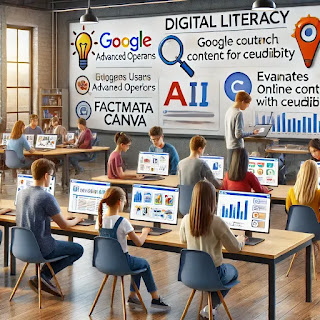What AI Can’t Do in Education
Despite its growing role in classrooms, AI has significant limitations in education and cannot replace human teachers. Here are 10 key areas where AI falls short in education:
1. AI Can’t Replace Human Teachers
- AI lacks the emotional intelligence, intuition, and adaptability of human educators.
- Teaching is not just about delivering information—it involves mentorship, motivation, and deep interpersonal engagement.
- Example: AI tutors can answer student questions, but they cannot inspire students, foster curiosity, or provide encouragement like a teacher can.
📌 What AI Can Do? Assist with lesson planning, grading, and tutoring.
📌 What AI Can’t Do? Build personal relationships with students or provide mentorship.
2. AI Struggles with Student Motivation and Engagement
- AI can provide personalized content, but it doesn’t understand the psychological and emotional factors that drive student learning.
- Students need human encouragement, interactive discussions, and emotional support—things AI lacks.
- Example: A student struggling with self-confidence may need a teacher’s encouragement, not just AI-generated feedback.
📌 What AI Can Do? Suggest personalized exercises based on student performance.
📌 What AI Can’t Do? Recognize when a student is feeling discouraged and offer emotional support.
3. AI Lacks Deep Understanding of Human Learning Processes
- AI is pattern-based, but human learning is complex, iterative, and highly individual.
- AI doesn’t fully grasp how students make connections, retain knowledge, or apply concepts in real-world scenarios.
- Example: AI can identify which students struggle with fractions, but it cannot diagnose whether the issue is due to a learning disability, lack of interest, or other cognitive factors.
📌 What AI Can Do? Analyze student data and suggest areas for improvement.
📌 What AI Can’t Do? Diagnose learning gaps with the depth that a human teacher can.
4. AI Can’t Foster Creativity Like a Teacher Can
- AI can generate essays, music, and artwork, but it cannot teach students to think creatively and critically on their own.
- Creative subjects like art, music, and storytelling require original thought, personal interpretation, and imagination, which AI lacks.
- Example: AI can compose a poem but can’t teach students how to express their personal emotions through poetry.
📌 What AI Can Do? Provide prompts and templates to support creative projects.
📌 What AI Can’t Do? Teach students why creativity matters or how to think outside the box.
5. AI Can’t Build Trust and Classroom Community
- Learning happens in a social environment—AI cannot replicate the sense of belonging and trust that human teachers cultivate.
- Students learn best when they feel safe, supported, and part of a learning community, which AI cannot provide.
- Example: A robot tutor may deliver great lessons, but it can’t replace the trust students have in their favorite teacher.
📌 What AI Can Do? Automate administrative tasks to free up teachers for more personal interaction.
📌 What AI Can’t Do? Build classroom culture or foster meaningful student-teacher relationships.
6. AI Has No Emotional Intelligence or Empathy
- AI can detect sentiment (e.g., "happy" or "sad" tones in writing) but cannot truly understand human emotions.
- AI cannot recognize when a student is struggling emotionally and adjust its approach accordingly.
- Example: AI may notice a drop in a student’s performance but won’t recognize that the student is dealing with anxiety, family issues, or bullying.
📌 What AI Can Do? Flag potential concerns based on data patterns.
📌 What AI Can’t Do? Provide emotional support or adjust teaching based on students’ feelings.
7. AI Can’t Make Ethical or Moral Judgments in Teaching
- AI follows data-driven patterns but cannot make nuanced ethical decisions.
- Education involves complex moral choices, such as how to discipline a student fairly or how to handle sensitive classroom discussions.
- Example: If AI is used for automated grading, it may unfairly penalize students for creativity or non-traditional answers that don’t match its dataset.
📌 What AI Can Do? Assist in grading and administrative tasks.
📌 What AI Can’t Do? Make fair, ethical, and context-aware decisions in teaching.
8. AI Struggles with Cultural Sensitivity and Inclusivity
- AI is trained on existing datasets, which often contain biases related to race, gender, and culture.
- AI may unintentionally reinforce stereotypes instead of promoting inclusivity and diverse perspectives.
- Example: AI-generated history lessons might reflect Eurocentric narratives while ignoring diverse perspectives.
📌 What AI Can Do? Provide access to diverse resources if properly programmed.
📌 What AI Can’t Do? Ensure cultural sensitivity and representation without human oversight.
9. AI Can’t Adapt to Unpredictable Classroom Situations
- AI can handle structured, predictable tasks, but it struggles with the unpredictability of real-world classrooms.
- Teachers adjust lessons on the spot based on student needs, classroom energy, and unexpected interruptions—something AI cannot do.
- Example: AI can plan a scripted lesson, but it can’t adapt if students suddenly ask deep, off-topic questions.
📌 What AI Can Do? Provide structured lesson plans and automated responses.
📌 What AI Can’t Do? Adjust dynamically to the fluid, ever-changing nature of classrooms.
10. AI Relies on Data—But Learning is More Than Just Data
- AI needs large amounts of data to function, but many aspects of learning aren’t easily measurable.
- Personal growth, curiosity, leadership, and perseverance—some of the most valuable student traits—can’t be fully captured in AI models.
- Example: AI can measure test scores, but it can’t assess personal growth, resilience, or a student’s love for learning.
📌 What AI Can Do? Track performance metrics and trends.
📌 What AI Can’t Do? Measure the intangibles of learning, like curiosity, confidence, and perseverance.
Final Thoughts: The Role of AI in Education
✔ AI enhances education but cannot replace human teachers.
✔ AI supports personalized learning, but it lacks emotional intelligence, ethical judgment, and deep understanding.
✔ The future of education is not AI replacing teachers but AI working alongside them to improve learning experiences.











